Difference between revisions of "AY1516 T2 Inpatient Meals Survey Findings"
Poojat.2012 (talk | contribs) |
Poojat.2012 (talk | contribs) |
||
| (4 intermediate revisions by the same user not shown) | |||
| Line 30: | Line 30: | ||
<div style="font-size:22px">Overall Analysis</div> | <div style="font-size:22px">Overall Analysis</div> | ||
For the analysis, we first see the survey feedback for the month of November as it is the more recent survey conducted and will provide the most accurate results for the analysis. At first, we see the overall view of the importance and satisfaction values for all attributes.<br/> | For the analysis, we first see the survey feedback for the month of November as it is the more recent survey conducted and will provide the most accurate results for the analysis. At first, we see the overall view of the importance and satisfaction values for all attributes.<br/> | ||
| − | <center>[[Image:DataStats-Analysis1.png| | + | <center>[[Image:DataStats-Analysis1.png|1000px]]</center><br/> |
| − | As seen from the above graph, the most important attribute for the patients are “Taste of the Meal Served”, “Temperature of Food” and “Variety of | + | As seen from the above graph, the most important attribute for the patients are “Taste of the Meal Served”, “Temperature of Food” and “Variety of Food” Thus, it is important for us to look deeper into these attributes and see the satisfaction of the patients and how it can be improved. The less important attribute for the patients is “Presentation of the Meals Served.” Thus, lesser focus should be put into maintaining or improving this attribute for the meals.<br/> |
| − | + | ||
| − | + | Also, the above figure clearly shows that, patients are least satisfied with the taste and variety of the meals. Since, these two attributes are extremely important for the patients, the hospital should focus more on improving these attributes. | |
Moreover, it can be seen that the patients are extremely satisfied with the presentation of the meals. The satisfaction level of this attribute is higher than the importance level. Thus, NUH is wasting more resources in this attribute than is required. They can try and save up resources from presentation of meals and put in improving the taste and variety of meals served.<br/> | Moreover, it can be seen that the patients are extremely satisfied with the presentation of the meals. The satisfaction level of this attribute is higher than the importance level. Thus, NUH is wasting more resources in this attribute than is required. They can try and save up resources from presentation of meals and put in improving the taste and variety of meals served.<br/> | ||
<br/> | <br/> | ||
| Line 41: | Line 41: | ||
<center>[[Image:DataStats-Analysis4.png|700px]]</center><br/> | <center>[[Image:DataStats-Analysis4.png|700px]]</center><br/> | ||
<center>[[Image:DataStats-Analysis5.png|700px]]</center><br/> | <center>[[Image:DataStats-Analysis5.png|700px]]</center><br/> | ||
| − | As seen from the above graphs, taste of meal is an extremely important attribute for all wards, patient types and diet types. The service gap between the satisfaction and importance is a lot for the patients in Ward B1 and C. This means, NUH should look at improving the taste of the meals for the patients in these 2 wards the most as they are most dissatisfied. | + | |
| + | As seen from the above graphs, taste of meal is an extremely important attribute for all wards, patient types and diet types. The service gap between the satisfaction and importance is a lot for the patients in Ward B1 and C. This means, NUH should look at improving the taste of the meals for the patients in these 2 wards the most as they are most dissatisfied. Also, these 2 wards are where subsidized patients are admitted. Therefore, it is easy to explain why the meal service might be poor in these two wards. | ||
As for the diet types, patients with special diet types are more dissatisfied with the taste of the meal. This may be due to the dietary restrictions of the patients. Thus, NUH needs to try and improve the taste of special diets keeping in mind the dietary requirements. They need to be more innovative with the restrictions of the diets. | As for the diet types, patients with special diet types are more dissatisfied with the taste of the meal. This may be due to the dietary restrictions of the patients. Thus, NUH needs to try and improve the taste of special diets keeping in mind the dietary requirements. They need to be more innovative with the restrictions of the diets. | ||
| Line 47: | Line 48: | ||
On analysing the reasons, it is seen that the reason for dissatisfaction for taste is mostly because either the food is bland and tasteless or it is too oily. Thus, NUH should look into improving the taste by using these suggestions.<br/> | On analysing the reasons, it is seen that the reason for dissatisfaction for taste is mostly because either the food is bland and tasteless or it is too oily. Thus, NUH should look into improving the taste by using these suggestions.<br/> | ||
<br/> | <br/> | ||
| − | <div style="font-size:22px"> | + | <div style="font-size:22px">Filters for Wards, Patients and Diet</div><br/> |
| − | |||
| − | |||
| − | |||
| − | |||
| − | |||
| − | |||
<center>[[Image:DataStats-Analysis9.png|700px]]</center><br/> | <center>[[Image:DataStats-Analysis9.png|700px]]</center><br/> | ||
<center>[[Image:DataStats-Analysis10.png|700px]]</center><br/> | <center>[[Image:DataStats-Analysis10.png|700px]]</center><br/> | ||
| − | |||
The service gap for variety is big for Subsidised patient. They seem to be dissatisfied with the variety. NUH should thus, look into increasing the variety and extending the menu for subsidised patients. Also, B1 ward class seem to be extremely dissatisfied with the variety too. Thus, we would suggest NUH to increase the variety of meals in the menu for subsidised patients in ward class B1. Patients with special diets also seem to be dissatisfied with the variety, but given the restrictions of their dietary requirements, it might be difficult to increase the variety of meals. | The service gap for variety is big for Subsidised patient. They seem to be dissatisfied with the variety. NUH should thus, look into increasing the variety and extending the menu for subsidised patients. Also, B1 ward class seem to be extremely dissatisfied with the variety too. Thus, we would suggest NUH to increase the variety of meals in the menu for subsidised patients in ward class B1. Patients with special diets also seem to be dissatisfied with the variety, but given the restrictions of their dietary requirements, it might be difficult to increase the variety of meals. | ||
From the feedback, it is seen that patients with Indian and Muslim food preferences have most complaints on the variety. Thus, NUH should look into increasing the variety of food on the menu for these cuisines. | From the feedback, it is seen that patients with Indian and Muslim food preferences have most complaints on the variety. Thus, NUH should look into increasing the variety of food on the menu for these cuisines. | ||
Latest revision as of 03:23, 15 April 2016

Analysis
For the analysis, we first see the survey feedback for the month of November as it is the more recent survey conducted and will provide the most accurate results for the analysis. At first, we see the overall view of the importance and satisfaction values for all attributes.
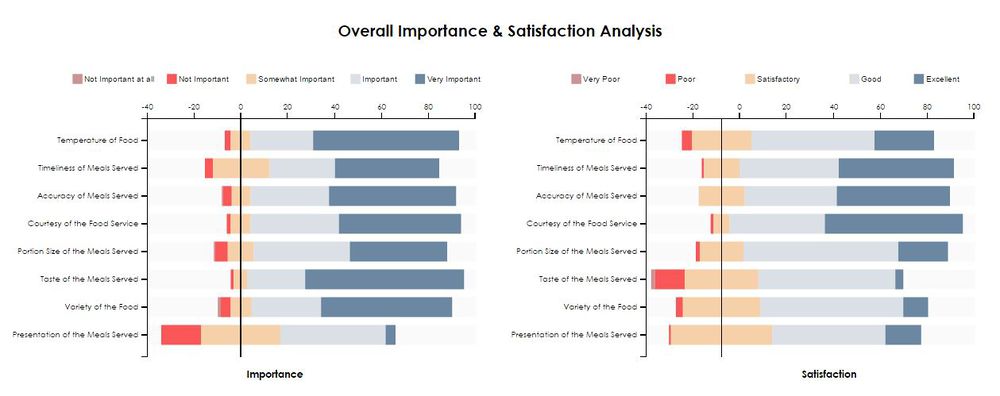
As seen from the above graph, the most important attribute for the patients are “Taste of the Meal Served”, “Temperature of Food” and “Variety of Food” Thus, it is important for us to look deeper into these attributes and see the satisfaction of the patients and how it can be improved. The less important attribute for the patients is “Presentation of the Meals Served.” Thus, lesser focus should be put into maintaining or improving this attribute for the meals.
Also, the above figure clearly shows that, patients are least satisfied with the taste and variety of the meals. Since, these two attributes are extremely important for the patients, the hospital should focus more on improving these attributes.
Moreover, it can be seen that the patients are extremely satisfied with the presentation of the meals. The satisfaction level of this attribute is higher than the importance level. Thus, NUH is wasting more resources in this attribute than is required. They can try and save up resources from presentation of meals and put in improving the taste and variety of meals served.
After the overall view, we analyze each attribute by wards, type of patients and type of diets. This will give a more accurate view of where the improvements can be made.
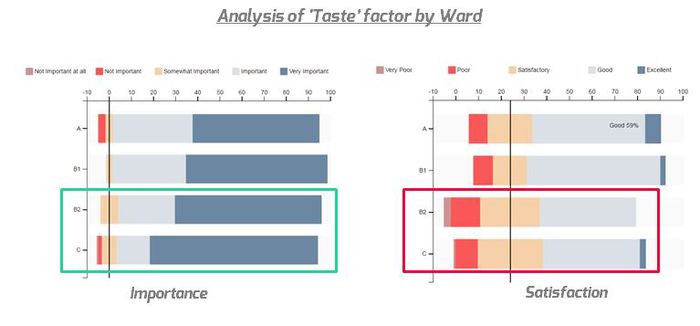
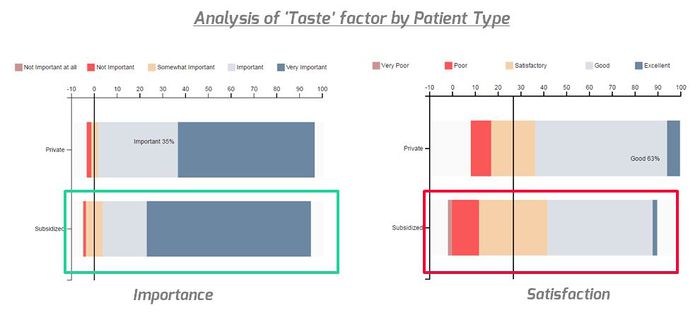
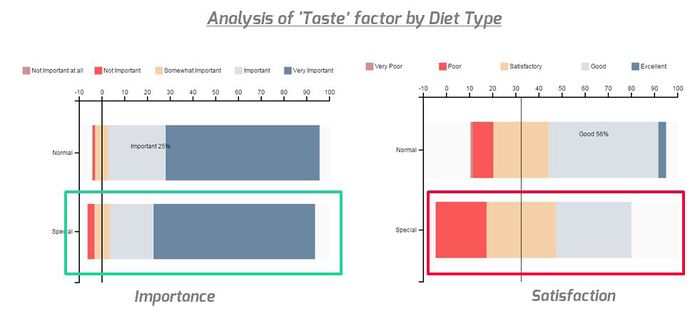
As seen from the above graphs, taste of meal is an extremely important attribute for all wards, patient types and diet types. The service gap between the satisfaction and importance is a lot for the patients in Ward B1 and C. This means, NUH should look at improving the taste of the meals for the patients in these 2 wards the most as they are most dissatisfied. Also, these 2 wards are where subsidized patients are admitted. Therefore, it is easy to explain why the meal service might be poor in these two wards.
As for the diet types, patients with special diet types are more dissatisfied with the taste of the meal. This may be due to the dietary restrictions of the patients. Thus, NUH needs to try and improve the taste of special diets keeping in mind the dietary requirements. They need to be more innovative with the restrictions of the diets.
On analysing the reasons, it is seen that the reason for dissatisfaction for taste is mostly because either the food is bland and tasteless or it is too oily. Thus, NUH should look into improving the taste by using these suggestions.
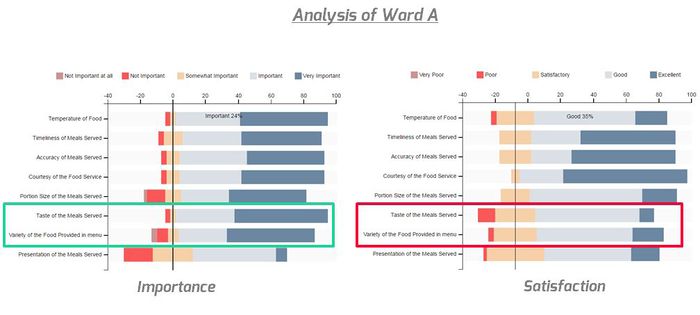
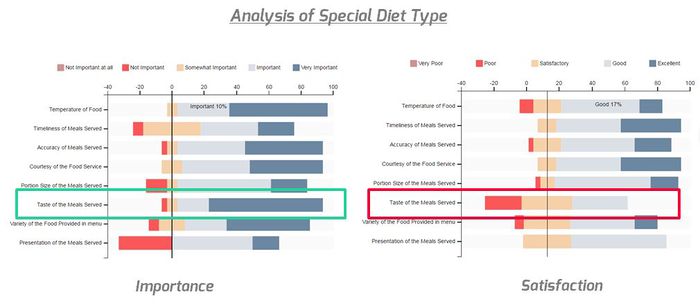
The service gap for variety is big for Subsidised patient. They seem to be dissatisfied with the variety. NUH should thus, look into increasing the variety and extending the menu for subsidised patients. Also, B1 ward class seem to be extremely dissatisfied with the variety too. Thus, we would suggest NUH to increase the variety of meals in the menu for subsidised patients in ward class B1. Patients with special diets also seem to be dissatisfied with the variety, but given the restrictions of their dietary requirements, it might be difficult to increase the variety of meals. From the feedback, it is seen that patients with Indian and Muslim food preferences have most complaints on the variety. Thus, NUH should look into increasing the variety of food on the menu for these cuisines.